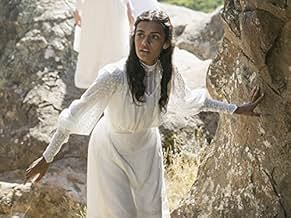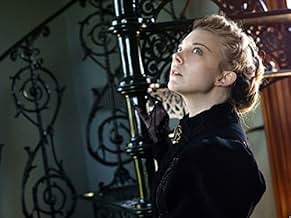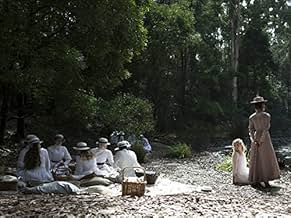Tre studentesse del collegio Appleyard e una loro insegnante scompaiono misteriosamente nel giorno di San Valentino del 1900, durante una gita picnic ai piedi del gruppo roccioso di Hanging ... Leggi tuttoTre studentesse del collegio Appleyard e una loro insegnante scompaiono misteriosamente nel giorno di San Valentino del 1900, durante una gita picnic ai piedi del gruppo roccioso di Hanging Rock in Australia.Tre studentesse del collegio Appleyard e una loro insegnante scompaiono misteriosamente nel giorno di San Valentino del 1900, durante una gita picnic ai piedi del gruppo roccioso di Hanging Rock in Australia.
- Premi
- 7 vittorie e 10 candidature totali
Sfoglia gli episodi
Riepilogo
Reviewers say 'Picnic at Hanging Rock' is visually stunning with compelling narratives and expanded character backstories, yet criticized for pacing and historical inaccuracies. Praised for performances by Natalie Dormer and young actresses, it faces backlash for casting and deviations from the source material. Lauded for cinematography and production design, it is faulted for over-direction and excessive slow motion. The supernatural elements are both celebrated for mystery and criticized for lacking subtlety and coherence.
Recensioni in evidenza
Tedious 6-hour series based on the classic 1975 Australian film about a group of female students and a teacher who disappear at Hanging Rock on Valentine's Day in 1900. Everything in this series is wrong: the casting of Mrs. Appleyard, the behavior and attitudes of the girls, and the hideous and anachronistic music.
The added backstories to the various characters is obvious padding and distracts from the central mystery that gets sidelined by a bunch of soap opera hogwash about runaway wives, separated siblings, and vaguely gay and lesbian leanings. None of this claptrap has anything to do with the disappearances.
Natalie Dormer is miscast in the central role of of headmistress (Rachel Roberts starred in the original), and she plays the part much too broadly. We don't need to know all the particulars; all we need to know is that she is stern and mysterious. The only acting standout in the cast is James Hoare as Albert, and he is only tangentially connected to the mystery.
Then there's the modern PC casting of the half-black student enrolled in a white girls' finishing school in the Victorian Australian Outback in 1900. Ya right! A total of 3 directors worked on the 6 episodes, with at least two writers working on separate episodes. That's just a clue as to why this mess is so disjointed and lacking in any unified vision whatsoever.
The added backstories to the various characters is obvious padding and distracts from the central mystery that gets sidelined by a bunch of soap opera hogwash about runaway wives, separated siblings, and vaguely gay and lesbian leanings. None of this claptrap has anything to do with the disappearances.
Natalie Dormer is miscast in the central role of of headmistress (Rachel Roberts starred in the original), and she plays the part much too broadly. We don't need to know all the particulars; all we need to know is that she is stern and mysterious. The only acting standout in the cast is James Hoare as Albert, and he is only tangentially connected to the mystery.
Then there's the modern PC casting of the half-black student enrolled in a white girls' finishing school in the Victorian Australian Outback in 1900. Ya right! A total of 3 directors worked on the 6 episodes, with at least two writers working on separate episodes. That's just a clue as to why this mess is so disjointed and lacking in any unified vision whatsoever.
There's so much that's wrong with this new version of the Australian classic that it's hard to know where to start. First there's the direction - tricksy, flashy and sprinkled with "creative" flourishes more evocative of 80s music videos than Australia in 1900. It's uneven from episode to episode, unhelpful in establishing the kind of eerie, dreamy atmosphere that the story demands, and frequently just yanks us out of the period and out of the story. The performances are jarringly uneven too, ranging from naturalistic (though, unfortunately, in an anachronistic contemporary style) to fruity amateur-theatrical emoting, with highly questionable accents. The location for the girl's school is ludicrously lavish, a sprawling mansion replete with marble columns and ornate fixtures - an unlikely girl's school anywhere in Australia at any time, but utterly nonsensical in a remote rural area in 1900. And then there's the depiction of the bush and hanging rock itself - over-saturated hues that make everything seem green and lush, and even a shimmering lake. It looks more English than Australian, and absolutely nothing like the dry Macedon Ranges in which the story is set. The same lack of care extends to the dialogue and the depiction of social conventions of the time, with almost every exchange between "the gentry" and the lower orders being hilariously unlikely. If you watch this Picnic with the expectation of something eerie and other-worldly, you may well find it... and it's most likely the sound of poor Joan Lindsay turning in her grave.
People may not be aware that the novel PICNIC AT HANGING ROCK is very short, just over 200 pages. It works ideally as a 2-hour film but to stretch it out into 6-hours results in a heavily padded and downright dull miniseries. In the first hour, the girls disappear and the filmmakers bungle this key scene. There's no set- up, no sense of dread, so the main focus of the entire project falls flat. And that's in the first hour! For the rest of the miniseries, the characters involved seem more concerned about the girl's school than Hanging Rock. We see the local community searching for the girls, but at the same time, backstories of pretty much every character are introduced. Episodes 3 and 4 add zero to the narrative and you can see the filmmakers are desperate to keep us engaged with some poorly staged jump scares: an animal nailed to the wall! A pile of maggots at one character's feet! But why? No explanation. This is a much harsher PICNIC than Peter Weir's classic film of 1975. At times, the miniseries comes across as LA RESIDENCIA (THE HOUSE THAT SCREAMED), the 1970 shocker with Lili Palmer who stars as the headmistress of a nineteenth-century French boarding school for girls. Some girls are whipped, others are slapped...but it isn't until the 5th and 6th episodes that we're reminded girls went missing. Whatever happened to them? Parents come and remove their children from the school and there are more flashbacks and backstories. The women talk about being "free" but that's never explained either. The girls who vanish "take a vow"...to what end? Stretched to the breaking point to six hours, the miniseries tries to answer questions that are never asked and, worst of all, forgets that Hanging Rock is the center of the story, not the school house.
It's unlikely that approximately six hours of TV are required to make a spin-off from a source-novel of less-than two-hundred pages. 'Picnic at Hanging Rock', like Conrad's 'Heart of Darkness', draws power from what's left unsaid. Whereas Joan Lindsay, in the original book, has the imagination to step-inside an earlier time-period, this adaptation simply superimposes twenty-first century mores onto a world where they don't belong. Nearly everyone has become 'pan-sexual'; and it's highly unlikely that a young aboriginal woman would have attended a posh girls' school in Australia c.1900 (no matter how politically correct this might be). The episodes are often terribly over-directed. Natalie Dormer seemed miscast as 'Mrs Appleyard'. 'Miranda', 'Irma' and 'Marion' are played by exquisitely beautiful actresses, but the characters come across as annoying and shallow. Lola Bessis really shines in an expanded characterization of 'Mademoiselle'.
In the 1967 book, the missing girls are kept in the background, becoming more-of an idea or enigmatic symbol. A large part of the novel consists of the author - a woman - writing about women being viewed by men (Michael, a young, upper-class Englishman, and his working-class Aussie friend, Albert). Bringing the senior-boarders right into the foreground distorts the story, producing diminishing returns. And 'Mrs Appleyard' has been disastrously rewritten. More is definitely less in this case.
In the 1967 book, the missing girls are kept in the background, becoming more-of an idea or enigmatic symbol. A large part of the novel consists of the author - a woman - writing about women being viewed by men (Michael, a young, upper-class Englishman, and his working-class Aussie friend, Albert). Bringing the senior-boarders right into the foreground distorts the story, producing diminishing returns. And 'Mrs Appleyard' has been disastrously rewritten. More is definitely less in this case.
My only real qualms with this were the ending (which I can blame the original author for, rather than the series writers), the weird decision to make many of the characters bisexual, and the excessive dreamy scenes others mentioned with birds or blurry imagery meant to take up extra time. Aboriginal descendants were in the film (though that may not be historically accurate) and brought up frequently enough in regards to Hanging Rock that I thought they did a decent enough job to avoid complaints about that.
Other than that, without having seen the original version or reading the novel, I can say that this is a show worth watching, and I didn't regret it. I really liked nearly all of the female central characters, and thought they did superb acting jobs. I also thought the character development was pretty good, although it could have been a little better in regards to Sara, whose character was one of the best.
I really liked the theme of the show in regards to true freedom, and the idea that some birds just weren't meant to be caged.
On a side note, it's sad but interesting that Amazon won't allow anyone to review the show on their website as of 6/9/2018 due to negative reviews. What a shame.
Other than that, without having seen the original version or reading the novel, I can say that this is a show worth watching, and I didn't regret it. I really liked nearly all of the female central characters, and thought they did superb acting jobs. I also thought the character development was pretty good, although it could have been a little better in regards to Sara, whose character was one of the best.
I really liked the theme of the show in regards to true freedom, and the idea that some birds just weren't meant to be caged.
On a side note, it's sad but interesting that Amazon won't allow anyone to review the show on their website as of 6/9/2018 due to negative reviews. What a shame.
Lo sapevi?
- QuizNatalie Dormer nicknamed the sunglasses she wears in the series her "Gary Oldman glasses" in reference to similar sunglasses that the actor wore in Dracula di Bram Stoker (1992).
I più visti
Accedi per valutare e creare un elenco di titoli salvati per ottenere consigli personalizzati
- How many seasons does Picnic at Hanging Rock have?Powered by Alexa
Dettagli
- Data di uscita
- Paese di origine
- Sito ufficiale
- Lingue
- Celebre anche come
- Пікнік біля Навислої скелі
- Luoghi delle riprese
- Aziende produttrici
- Vedi altri crediti dell’azienda su IMDbPro
- Tempo di esecuzione
- 51min
- Colore
- Mix di suoni
- Proporzioni
- 2.00 : 1
Contribuisci a questa pagina
Suggerisci una modifica o aggiungi i contenuti mancanti





































